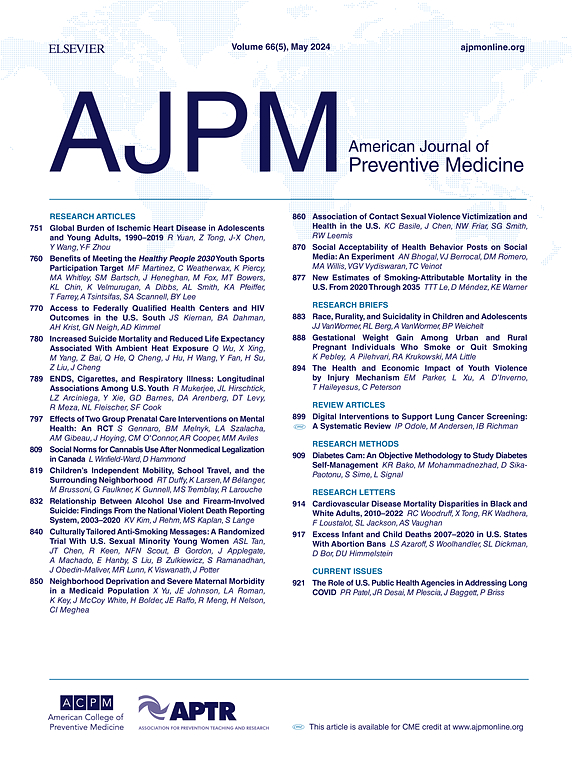有物质使用障碍的参保成人的牙科保健利用。
IF 4.5
2区 医学
Q1 MEDICINE, GENERAL & INTERNAL
引用次数: 0
摘要
简介:低收入的参加医疗补助的成年人可能有较差的口腔健康和经历物质使用障碍(sud)。尽管越来越多的证据表明,全面的牙科保健可以改善SUD的预后,但缺乏SUD和牙科保健利用重叠的证据。这项研究旨在填补这一空白。方法:本横断面研究使用了转换医疗补助统计信息系统分析文件中的2019年数据,包括超过3000万年龄在21至64岁之间的非双重资格医疗补助登记成年人。聚类稳健标准误差逻辑回归模型用于预测接受早期牙科护理的几率。分析于2024年进行。结果:在全国范围内,每1000名参加医疗补助计划的成年人中有56.45人被诊断患有SUD。各州的SUD患病率存在显著差异,每1000名成年人中有27.11至103.45例。平均每1000名成年人中有173.78人接受了牙科护理,尽管各州的比例差异很大,从1.69到347.27不等。生活在医疗补助牙科覆盖范围广泛的州的成年人的牙科保健使用率最高,每1000名患有SUD的成年人中有270.38人,每1000名没有SUD的成年人中有215.39人。参加医疗补助计划的成年人中,患有SUD的人接受早期牙科护理的几率比没有SUD的人低42%。结论:本研究发现各州的SUD患病率和牙科保健使用率存在相当大的差异。需要进一步的研究来揭示导致这些变化的因素,并为政策和临床干预提供信息,以改善参加医疗补助的成年人,特别是患有SUD的成年人的牙科护理机会。本文章由计算机程序翻译,如有差异,请以英文原文为准。
Dental Care Utilization Among Medicaid-Enrolled Adults With Substance Use Disorder
Introduction
Low-income Medicaid-enrolled adults are likely to have poor oral health and experience substance use disorders. Despite emerging evidence that comprehensive dental care can improve substance use disorder outcomes, there is a lack of evidence about the overlap of substance use disorder and dental care utilization. This study aims to fill that gap.
Methods
This cross-sectional study used 2019 data from the Transformed Medicaid Statistical Information System Analytic Files and included over 30 million nondually eligible Medicaid-enrolled adults aged 21–64 years. Clustered-robust SE logistic regression models were used to predict the odds of receiving early-stage dental care. Analyses were performed in 2024.
Results
Nationally, 56.45 per 1,000 Medicaid-enrolled adults were diagnosed with substance use disorders. There was significant variation in substance use disorder prevalence across states, ranging from 27.11 to 103.45 per 1,000 adults. On average, 173.78 adults per 1,000 accessed dental care, although access varied significantly across states, ranging from 1.69 to 347.27 per 1,000. Adults living in states with extensive Medicaid dental coverage had the highest rates of dental care utilization: 270.38 per 1,000 adults with substance use disorders and 215.39 per 1,000 adults without substance use disorders. The odds of receiving early-stage dental care were 42% lower for Medicaid-enrolled adults with substance use disorders than for those without substance use disorders.
Conclusions
This study found considerable variation in the prevalence of substance use disorders and dental care utilization across states. Further research is needed to uncover the factors driving these variations and inform policy and clinical interventions to improve dental care access for Medicaid-enrolled adults, especially those with substance use disorders.
求助全文
通过发布文献求助,成功后即可免费获取论文全文。
去求助
来源期刊

American Journal of Preventive Medicine
医学-公共卫生、环境卫生与职业卫生
CiteScore
8.60
自引率
1.80%
发文量
395
审稿时长
32 days
期刊介绍:
The American Journal of Preventive Medicine is the official journal of the American College of Preventive Medicine and the Association for Prevention Teaching and Research. It publishes articles in the areas of prevention research, teaching, practice and policy. Original research is published on interventions aimed at the prevention of chronic and acute disease and the promotion of individual and community health.
Of particular emphasis are papers that address the primary and secondary prevention of important clinical, behavioral and public health issues such as injury and violence, infectious disease, women''s health, smoking, sedentary behaviors and physical activity, nutrition, diabetes, obesity, and substance use disorders. Papers also address educational initiatives aimed at improving the ability of health professionals to provide effective clinical prevention and public health services. Papers on health services research pertinent to prevention and public health are also published. The journal also publishes official policy statements from the two co-sponsoring organizations, review articles, media reviews, and editorials. Finally, the journal periodically publishes supplements and special theme issues devoted to areas of current interest to the prevention community.
 求助内容:
求助内容: 应助结果提醒方式:
应助结果提醒方式:


